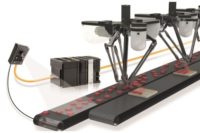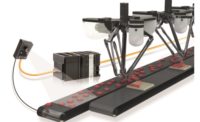Feature for pick and place robots increases productivity

Robotic pick & place applications are booming with no end in sight. Compared with fixed machine concepts, engineers can use robotics to increase productivity and flexibility, while at the same time reducing costs.
The productivity benchmark for automated pick & place is the number of products that can be successfully picked up and placed in a target position per minute.
To achieve the best possible results, pick & place robots must operate as efficiently as possible and avoid idle time. This topic becomes even more critical with multiple robots operating in a shared workspace.
New technology from KEBA (www.keba.com/en) makes it possible to achieve a more productive and flexible pick & place system, with lower maintenance and energy costs. This is possible thanks to KEBA’s new “Look Ahead Path Planning” feature for multiple robots operating in a shared workspace.
The general principle of this new feature is to pick & place the highest number of products per minute, while at the same time only moving “as fast as necessary”. This means using vision systems, advanced algorithms and multi-robot control to look at products moving down a conveyor belt, take into account the position and workspace of each robot and intelligently plan the movement of each robot to maximize productivity and minimize mechanical stress on the system.
In a typical multi-robot pick & place system, shared workspace is blocked as a robot enters the space. Abrupt braking followed by fast accelerations result as additional robots wait and enter the shared space. The end result is limited productivity, increased stress on the robot’s mechanical elements and increased energy consumption. The risk of production stoppage increases with the additional mechanical stress, and at minimum more scheduled maintenance is required.
Idle time is the antithesis to productivity, especially in the case of robots. Constant "stop & go" in a typical pick & place system has a negative impact on performance. To continue with the planned path, the robot always has to accelerate out of inactivity, which costs valuable time and energy.
Lack of path planning also limits the effective workspace and therefore productivity of each robot in a typical pick & place system. In these systems, the robot cannot approach the object that is to be picked up until the object enters the robot’s defined workspace. As the object enters the workspace, the robot starts moving to the pick location. During this time the object continues moving along the conveyor belt, which can ultimately limit the effective workspace usage to less than half of what is theoretically available. As a result, the maximum number of products on the conveyor is limited, and the buffer volume is restricted. In some cases the use of additional robots is required to achieve the desired throughput.
KEBA took on these challenges when it added the Look Ahead Path Planning feature to its established KeMotion Packaging system for packaging robots.
Foreign objects are now included in the path planning, which includes other robots and products moving on a conveyor belt. Look Ahead Path Planning enables the KeMotion system to automatically react to upcoming events and use the most intelligent strategy to increase productivity. This feature is designed to be easy to use without the need for additional programming.
KAIRO, the easy to use robot programming environment from KEBA, is interpreted online in the KeMotion control system. Up to 30 program lines are planned in advance, which means the control system can say exactly where a robot will be seconds before its tool center point actually reaches the position. In addition, speed and acceleration are taken into account to avoid undesired peaks in the dynamic process of individual robot axes. Any changes in motion paths required for external events, such as machine stopping or tracking, takes place in the interpolation cycle.
Look Ahead Path Planning enhances this already sophisticated planning by taking into account foreign objects, such as other robots and products on a conveyor belt. Higher productivity with less mechanical stress and less energy consumption are achieved as a result of integrating the timing of these foreign objects into the path planning.
It also means that the KeMotion control system knows when products on a conveyor belt will reach the robot's workspace. Based on the current position of the robot, its speed toward the product is optimized so that it is picked as early as possible when it actually enters the robot's workspace. As a result, the robot takes full advantage of the workspace, and throughput is increased.
In pick & place applications with unstructured product flow, robots are constantly confronted with random idle time. The Look Ahead Path Planning feature from KEBA provides a solution to this challenge, resulting in significantly increased throughput and performance, less maintenance and less energy consumption.
In addition, the robot's workspace is maximized through the look ahead calculation of the robot's path. Products are picked at the earliest possible time, and the robot can efficiently compensate for fluctuations in product flow.
Thanks to Look Ahead Path Planning, jerky braking and accelerations commonly found when several robots are used in a shared workspace are a thing of the past.
In short, Look Ahead Path Planning with KEBA's KeMotion robotic control system comes with significant gains in productivity and great savings potential. Throughput is increased and maintenance and energy costs are effectively reduced.
Ultimately a principle familiar from driving lessons proves to be true of robotics: "If you always think ahead, you will reach your destination in less time, more safely and more economically."
There will be a live demonstration of the KeMotion system from October 28-31, 2012 at PACKEXPO Booth N-4773 in Chicago.
Looking for a reprint of this article?
From high-res PDFs to custom plaques, order your copy today!






